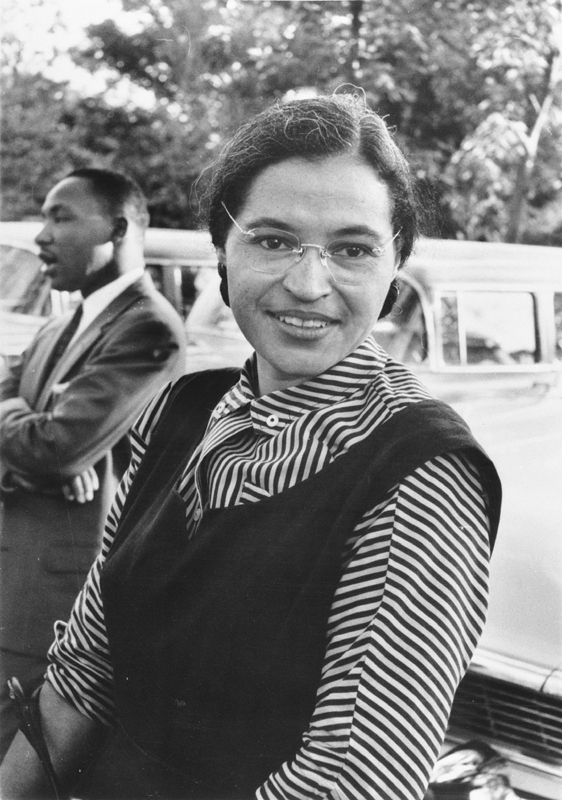Winner of the Fall 2016 StMU History Media Award for
Best Article in the Category of “People”
When one hears the name Rosa Parks, one is taken back in time to 1955, when a brave woman decided not to give up her seat. Rosa Parks was a woman who believed that the color of a person’s skin should not dictate the way a person is treated. Rosa Parks was a civil rights activist.

James McCauley, a skilled carpenter and stonemason, and Leona McCauley, a school teacher, were married on April 12, 1912, in Tuskegee, Alabama. Two months before their first anniversary, on February 4, 1913, in Tuskegee, Alabama they welcomed a daughter into their lives and named her Rosa Louise McCauley. On August 20, 1925 the McCauleys welcomed their son, Sylvester McCauley, into their family.1 The McCauley family decided to move to Abbeville, Alabama where they lived with James’s parents, sharing a bedroom with a large extended family. Rosa’s mother grew tired of the living arrangements and without her husband James around to support the family, she made the decision to leave. In 1917, when Rosa was only 4 years old, Leona took her two young children and moved back to Pine Level, Alabama where she and the children stayed with her parents. Rosa saw her father a year later when she was five and then again when she was an adult and married.2
Rosa received most of her education from her mother and grandfather as a little girl. In 1924, when Rosa was eleven years old, her mother enrolled her in the Montgomery Industrial School for Girls. The school was for African American girls seeking education; they were taught by mostly white teachers. The school focused on the domestic sciences of cooking, sewing, and housekeeping. The white people of the town accused the teachers of teaching racial equality and referred to them as Yankee black lovers. The school was later burned down by the Ku Klux Klan as they grew more powerful.3 After the Montgomery Industrial School for Girls closed in 1928, fifteen year old Rosa attended Booker T. Washington High School for her ninth grade year. She wanted to be a teacher just like her mother, so for her tenth grade year Rosa attended Alabama State Teachers College for Negros. Sadly, she had to drop out of school and return to Pine Level, Alabama to care for her grandmother who had grown ill. When her grandmother died in 1929, Rosa was only 16 years old. She moved back to Montgomery and found her first job making men’s blue denim work shirts at a textile factory. Soon after beginning her job in the factory, Rosa was forced to leave in order to care for her mother who had also grown ill.4 Rosa spent her teenage years cleaning houses and taking in sewing jobs. In 1931, Rosa met Raymond Parks, who worked as a barber and was a member of the National Association for the Advancement of Colored People (NAACP).5 The two fell in love and in December 1932, Rosa and Raymond were married. Raymond encouraged his new bride to go back to school so as to finish her education. This meant so much to her, and so Rosa completed her studies and received her high school diploma in 1934.6

By 1943 all buses in the South had long been segregated and had followed an extensive set of rules set forth by the bus drivers. Montgomery, Alabama was no exception to the segregation. All the buses had thirty-six seats; the first ten were reserved for whites only, ten seats in the back of the bus were for African Americans, and as for the sixteen seats in-between, these were for the bus drivers to decide. African Americans were frequently forced to give up their seats for whites and the bus drivers imposed their own segregation rules through the use of guns they carried with them.7
In November of 1943 Rosa boarded a bus in Montgomery, Alabama. African Americans were typically required to enter the bus from the doors located near the back of the bus, but since the bus was extremely crowded, Rosa was forced to enter from the front doors of the bus. The bus driver demanded she get off the bus and enter through the back door and Rosa refused, standing her ground and explaining to the bus driver that since she was already on the bus there was no need for her to get off because the back of the bus was already at capacity and she would not be able to enter from the back. The bus driver began tugging at Rosa’s coat to push her off the bus and so she decided to not create more of a scene and exited the bus.8
On December 1, 1955, Rosa headed to work at the Montgomery Fair Department Store on the Cleveland Avenue bus to Court Square. It was a normal day for Rosa, working her regular shift, busy as usual.9 Once work was over, Rosa was tired; her body ached, her feet hurt and were swollen from standing all day. Rosa walked to Court Square to wait for her bus and as soon as the first bus came, she saw that it was packed and decided to wait for the next one. Once the second bus arrived Rosa entered the bus, paid, and sat in the racially neutral middle section behind the movable sign which read “colored.”10 At the third stop, a group of whites entered the bus and since the last front seats were taken, one was left standing. The bus driver turned around and looked at Rosa. Rosa was shocked to see that it was the same bus driver she had had a problem with twelve years earlier. The driver, James F. Blake, began to shout at the passengers, “Move ya’ll, I want those two seats,” meaning he wanted Rosa to give up her seat. Rosa did not get up and Blake went straight to Rosa demanding she give her seat up. When Rosa still would not comply he warned her that he would have her arrested, to which she simply replied, “You may do that.”11
Once police arrived, Rosa was arrested, handcuffed and taken to the police station. At the station, Rosa was finger printed, photographed and placed in a cell. While in jail Rosa was treated badly. She requested a drink of water and a police officer yelled out to her “for whites only.” She even requested to make one phone call and was ignored. After requesting several times to make her phone call, she was finally given approval and she phoned her husband. Edgar Daniel Nixon, an African-American civil rights leader, paid a one-hundred dollar bond to bail Rosa out of jail. Rosa worked with Nixon as a branch secretary. In speaking with Nixon about the incident, Rosa decided to file suit and make a civil rights case regarding Montgomery’s bus segregation.12 On the day of trial, December 5, 1955, African Americans in Montgomery boycotted the buses and Rosa was found guilty of breaking segregation laws.13 The boycott proved to be a large protest, and it led to the formation of the Montgomery Improvement Association (MIA).14 On November 13, 1956, the Supreme Court ruled that bus segregation was unconstitutional and the boycott ended on December 20, 1956.15 Rosa became known as the mother of the Civil Rights Movement.16

Rosa Parks traveled and supported civil rights events and causes and even wrote an autobiography, “Rosa Parks: My Story.” In 1999, for all her accomplishments and beliefs as a strong African American, Rosa was awarded the Congressional Gold Medal, which is the highest honor in the United States presented to a civilian.17 On October 24, 2005, at the age of 92, Rosa Parks passed away. She became the first woman in the nation’s history to lie in state at the U.S. Capitol.18
Rosa Parks left a major impact on America and made history. She stood up for what was right for herself and for the people, not because of the color of their skin but because she believed that everyone should be treated equally. She boarded a bus at the end of a long work day, tired and wanting to go home, not realizing that she would forever change segregation in America. Rosa Parks was a very noble woman and she left behind a legacy that will never be forgotten.
- Salem Press Biographical Encyclopedia, January 2016, s.v. “Rosa Parks,” by Tammy K. Baggett. ↵
- Douglas Brinkley, Rosa Parks (Penguin Group Penguin Putnam Inc., 2000), 20-21. ↵
- Brinkley, Rosa Parks, 28, 29, 36. ↵
- Brinkley, Rosa Parks, 36. ↵
- Brinkley, Rosa Parks, 38. ↵
- Salem Press Biographical Encyclopedia, January 2016, s.v. “Rosa Parks,” by Tammy K. Baggett. ↵
- Brinkley, Rosa Parks, 57. ↵
- Brinkley, Rosa Parks, 58-59. ↵
- Salem Press Biographical Encyclopedia, January 2016, s.v. “Rosa Parks,” by Tammy K. Baggett. ↵
- Brinkley, Rosa Parks, 105. ↵
- Brinkley, Rosa Parks, 106-107. ↵
- Brinkley, Rosa Parks, 73, 108, 109, 111, 113, 114. ↵
- Brinkley, Rosa Parks, 152. ↵
- Brinkley, Rosa Parks, 134. ↵
- Brinkley, Rosa Parks, 152, 170. ↵
- Rosa Parks: “The First Lady of Civil Rights,” Bill of Rights Institute, March 2, 2012, http://billofrightsinstitute.org/rosaparks/. (accessed November 7, 2016). ↵
- Salem Press Biographical Encyclopedia, January 2016, s.v. “Rosa Parks,” by Tammy K. Baggett. ↵
- Salem Press Biographical Encyclopedia, January 2016, s.v. “Rosa Parks,” by Tammy K. Baggett. ↵




79 comments
Benjamin Voy
I was vaguely aware of Rosa Park and how she refused to get off her seat in a segregated America but I wasn’t fully knowledgable about the impact it had for African American rights. She was clearly a pioneer that steered the way for equality in American. Clearly, without her there may have not been such a big stepping stone for the minorities of America to been seen as equals. I truly enjoyed this article and can understand why it won best article in its chosen field.
Amber Aragon Alvarado
There’s nothing better than reading about one little action changing America forever. Rosa Parks was such an inspiring human being. I didn’t know her full story, so reading about her background enlightened me as it made my perspective of her a million times more respectable than it already was. Many things about Rosa Parks should influence society as a whole. She continuously struggled in her education career, not because she didn’t want to do it, but because outside problems continued to occur. The fact that she went back to get her diploma despite all she went through is truly amazing. Rosa Parks will always be known for her bravery as an individual and for all that surrounded her. Rosa changed many perspectives, but unfortunately today there’s still so much racism and unfairness. It was an honor reading about this individual. The article was put together very thoroughly! Great work.
Troy Leonard
Rosa Parks is one phenomenal woman in history. she stood up for what she believed in and wasn’t taking anything less. I find it really great how from her not giving up her seat would have such an impact on history and the way people think. ive always had this question, I wonder what it would be like today iff she would have never gave up her seat and people would have never boycotted the busses.
Priscilla Reyes
Rosa Parks, someone so worthy of an article! We learned about her and watched movies on the Civil Rights movement during grade school, but thank you so much for your work and for adding details such as the burning down of her high school, the bus driver she faced, and her days as a worker, activist and wife! She was a great woman and you did a great job.
Briana Bustamante
Amazing article. Rosa Parks was an inspiration to all people. I admire her convictions and determination. Thanks to Rosa Parks, the law was changed, and many people today can benefit from her single action. You did an excellent job presenting her life story. I especially liked the picture of Rosa Parks with President Clinton. She looks so happy and so proud standing in the Oval Office.
Gabriela Medrano
Rosa Parks was such a strong influential woman, and it is so amazing how one action can change so much in society and the rest of history. But when you come to think of it something like this is still taken care of in the same manner, jail time. It is not fair to incarcerate someone who is innocent. Civil rights movement started here with small actions like this and till today racism continues but no longer can be afflicted. Great article and nice topic!
Cameron Adelman
It’s always impressive to see how such a small act can snowball into something so much more; how small acts of heroism can inspire others even centuries later. It’s because of the work of people like Rosa Parks that equality for all people in America is not only a right, but an expectation. Fantastic work on this article, I think you did an outstanding job.
Mario De Leon
This was a very descriptive article about Rosa Parks. I think it is hard to truly understand the bravery she showed by her actions on the bus in 1995. I liked how the author didn’t just talk about the incident on the bus and talked about Rosa Parks’ life and a little background on the bus systems in the South.
Aaron Mcglown
Rosa parks was and still is a very influential person in not just black history but in american history and this article showed that. I didnt know that the bus driver had pulled a gun on her, that was new information. Its crazy to think that just by her saying “no”, that she would we such a hero in history. very good article!
Andrew Gray
This was a very well written article – it really did take my mind back to 1955! I just have to wonder how that bus driver must have felt watching Rosa Parks as she was literally writing history because of his ignorance. It really goes to show that you should treat others the way you would like to be treated. The Rosa Parks story was, as the story shows, a pivotal tipping point in history.